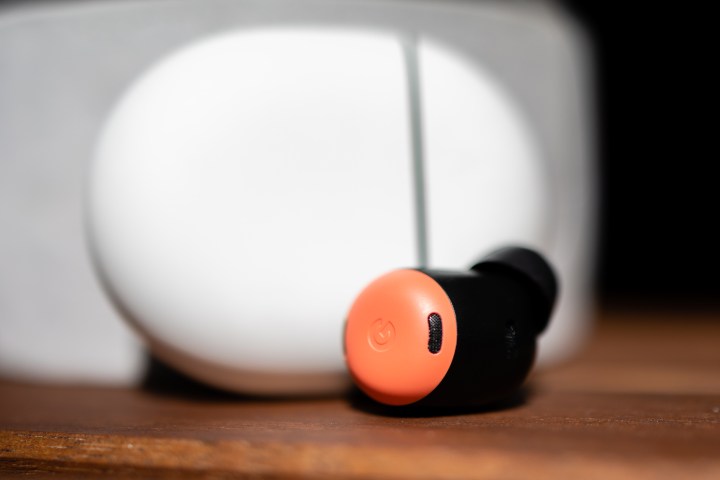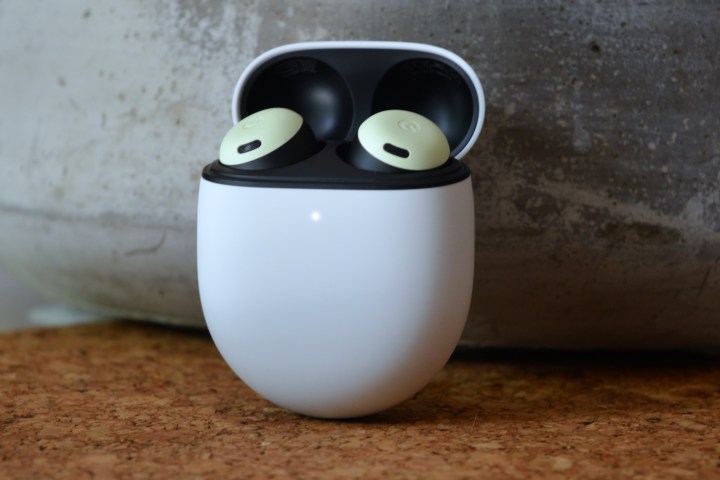Looking for the perfect set of wireless earbuds for your family of Android devices? You could do worse than the Google Pixel Buds Pro.
Packaged with multiple eartips for any canal shape, the Buds Pro sound awesome (as noted in our full Pixel Buds Pro review), fit comfortably, offer noise cancellation (finally!), and have the ability to link up with multiple Bluetooth devices at once. Like all things tech, though, they’re not completely glitch-proof.
What do you do when your Pixel Buds stop charging? And what if the audio suddenly drops out? Rest assured, we’ve got plenty of years of A/V experience to back you up. Here’s a list of some of the most common Pixel Buds Pro problems and how to solve them.

Phil Nickinson/Digital Trends
No sound
Whether the culprit is a finicky Bluetooth connection (which should be minimal with these buds) or a mismatched handshake between your Pixel Bud’s touch controls and a music streaming app, there are a handful of reasons why you may not be getting sound out of your earbuds.
But fear not: Here are a few troubleshooting tips and a couple of quick fixes you can try.
Step 1: First up on the troubleshooting end, let’s check the obvious: Go ahead and confirm that your Pixel Buds and charging case are charged, powered on, and that Bluetooth is enabled on whatever host device you’re currently connected to.
Step 2: Give either earbud a single tap (the play/pause command). If nothing happens, there’s a chance that whatever media streaming app or platform you’re using may not feature seamless compatibility with your Pixel Buds Pro.
In these cases, you may have to manually play and pause content from the app itself. This should be rare.
Step 3: Make sure that you’re running the latest firmware across your entire hardware and software spectrum. This means you’ll want everything from your phone/tablet and its music streaming apps to the Pixel Buds app itself to be updated.
Here’s how to update your Pixel Buds Pro.
Step 4: If Bluetooth is enabled on your host device, try toggling it off and then back on again. You may also want to try “forgetting” your Pixel Buds Pro from the device and then re-adding them.
Step 5: In some cases, a build-up of gunk and other detritus can hinder audio performance. Use a dry, lint-free cloth and adhesive putty (where applicable) to lift away any debris, then check to see if a little cleaning made a difference.
Pairing issues
The Pixel Buds Pro can be paired to a number of host devices both within and outside of the Android family, but actually getting your earbuds to link up with Bluetooth gear can sometimes be a bit of a hassle.
If you can encounter any pairing problems with your Pixel Buds Pro, here are a few things you can try.
Step 1: Whether you’re pairing to an Android, iOS, or other kind of Bluetooth-capable device, you’ll first want to make sure your Pixel Buds Pro are in pairing mode.
To do so, place your Pixel Buds in the charging case, then press and hold the Pairing button on the back of the case. Once the status light starts pulsing white, your buds have officially entered pairing mode.
Step 2: If you’re using an Android device running Android 6.0 or higher, you should receive a pop-up notification on your phone or tablet informing you that your Pixel Buds are attempting to connect. Select the notification and follow the quick prompts to link your earbuds.
You can also navigate to your phone’s Bluetooth settings to add your Pixel Buds by selecting Pair new device.
Step 3: For non-Android devices, head into your hardware’s Bluetooth menu and find your Pixel Buds under the My devices tab. Once you select them, they should start pairing.
Step 4: If they don’t, try “forgetting” and re-adding the Pixel Buds Pro to your host device.
After you’ve removed the Pixel Buds Pro from your device log, place the Pixel Buds in the charging case, leave the top open, then connect the case to a power source.
Step 5: Hold down the button on the back of the case for around 30 seconds. When the status light stops blinking, let go, and your Buds Pro case indicator should then start flashing white and orange, indicating your Buds are being fully reset. This will factory reset your Pixel Buds Pro.
Step 6: When the light flashes white, this means the reset is complete and you can attempt the pairing process again.

Simon Cohen / Digital Trends
Troubles with charging
Have you noticed your Pixel Buds are not getting charged up when you seat them in the charging case? This is where proper cleaning and upkeep of your earbuds and charging case become key for getting the optimal re-juice from your case to the Buds Pro.
Step 1: Use a dry, lint-free cloth to clean the charging contacts of your Buds Pro and inside the charging case.
Step 2: Make sure the earbuds are firmly seated in the charging case. To confirm a proper A-to-B connection, you should see the earbuds’ status light blink after each bud is successfully docked.
Opening and closing the charging case is another good way to adjust each bud into its correct charging position.
Factory reset when all else fails
Whatever bug or glitch your Buds Pro and/or host device may be experiencing, a solid factory reset of the Pixel Buds Pro will revert the earbuds to their out-of-the-box status, with all links from the buds to your Bluetooth devices eliminated and all default settings restored.
Step 1: Follow our in-depth explainer for how to properly factory reset your Pixel Buds Pro (which we briefly covered in this piece’s No Sound section).
Step 2: It also won’t hurt to do a hard reset of your host device. Completely power down your phone, tablet, laptop, or desktop, wait about 10 or 15 seconds, and then re-power.
Check out our full review of the Google Pixel Buds Pro. Not sure whether to opt for Android or Apple? Here’s our comparison of the Google Pixel Buds Pro versus the Apple AirPods Pro.
Editors’ Recommendations




